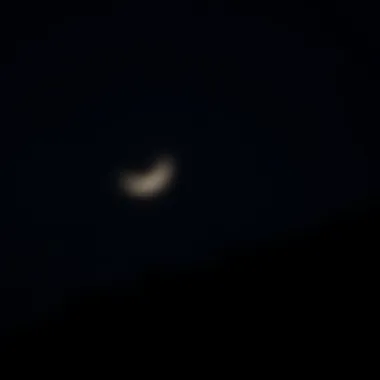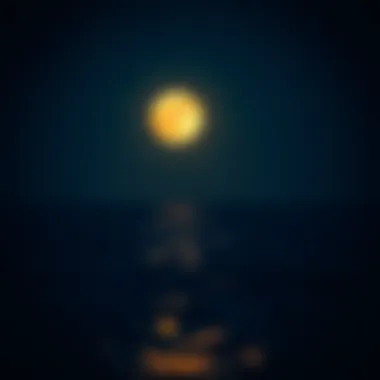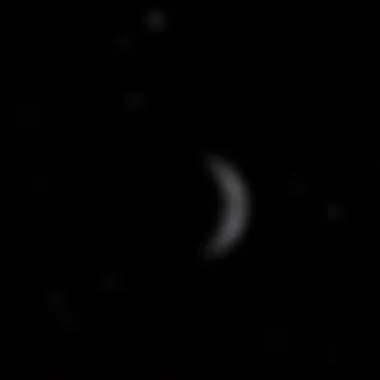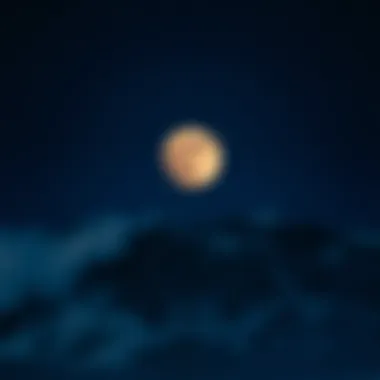Exploring the Monthly Cycle of Moon Phases


Intro
Understanding the moon phases presents a fascinating journey through the night sky. Every month, the moon dances through its phases, from the luminous New Moon to the resplendent Full Moon, creating a tapestry that affects tides, wildlife behavior, and even human emotions. Surfing enthusiasts and beachgoers rarely consider these nuanced lunar rhythms, yet they profoundly influence the surfing experience.
In this exploration, we’ll break down how each moon phase unfolds and its potential impacts—right from its connection to wave patterns to the timing of surf sessions. Let's dive deep into this monthly cycle, shedding light on how the dynamic relationship between the moon and Earth creates unique environmental conditions.
The phases begin with the New Moon, where the moon is practically invisible in the sky. This alignment of the sun, moon, and Earth starts the cycle anew. Each phase that follows—from waxing crescent to Full Moon and then waning back towards the New Moon—exhibits distinct traits and consequences.
We will look at how these subtle shifts influence not just nature but the pursuits of surfers and the patterns they follow based on lunar timing. By understanding these moon phases better, we can not only enhance surfing techniques but also help safeguard the coastal ecosystems that surfers cherish.
Let’s roll into the specifics, starting with an exploration of surfboard choices, which complements our understanding of moon phases' effects on surfing activities.
Prelims to Lunar Cycles
The phases of the moon serve as an exquisite reminder of nature's rhythm. Each month, our celestial body paints a vivid portrait across the night sky, transitioning through familiar forms. Understanding lunar cycles is not merely an academic pursuit; it’s essential for a variety of practical applications, particularly for those who spend time outdoors, like surfers, beach lifeguards, and marine biologists.
This article aims to unpack the importance of the lunar cycles and how they affect both our environment and our behavior. From tides influenced by these phases to cultural beliefs rooted in moon lore, understanding the lunar cycles can enrich our lives in meaningful ways.
Overview of the Moon's Influence
The moon has an expansive influence that often goes unnoticed. Its gravitational pull directly affects ocean tides, stimulating the rise and fall of sea levels. This is especially significant for surfers who rely on optimal wave conditions. Research shows that specific moon phases may also affect nightlife and animal behavior; for example, certain species might breed or forage more actively under specific lunar conditions, which can be crucial for marine biologists monitoring ecosystems.
As we track the moon’s phases, we are not just observing a distant rock in the sky but acknowledging a powerful force that has shaped life on Earth. This influence permeates the environment and extends to various aspects of daily life, from planting crops to timing significant events. The moon's cycles create a sense of continuity, serving as markers in time that many cultures across the globe have revered for centuries.
Importance of Monthly Moon Phases
Understanding the moon phases in any given month allows for a deeper connection to our surroundings. Each phase offers unique characteristics that can affect human activities and natural phenomena. For instance:
- New Moon: a time that many believe is perfect for setting intentions, and it also brings minimal light, which can affect nocturnal wildlife.
- Full Moon: often associated with heightened emotions and increased activity in both humans and wildlife.
Recognizing these rhythms can inform decision-making, enhance activities like fishing and surfing, and allow for greater harmony with nature's cycles. The monthly lunar phases offer insights into the ideal timings for various outdoor activities, from swimming to wave riding.
To sum up, taking the time to understand lunar cycles opens doors to a multitude of applications, both scientific and anecdotal. Keeping an eye on the moon's transitions can yield advice that goes beyond getting caught up in the tides - it can lead to a fulfilling relationship with our world.
The Science of Moon Phases
The science behind moon phases reveals the intricate dance between the Earth, the Moon, and the Sun. Understanding these lunar phases is not merely an academic exercise; it sheds light on numerous aspects ranging from agriculture to ocean behaviors. With knowledge of moon phases, surfers, instructors, beach lifeguards, and marine biologists can better predict conditions and patterns influenced by lunar activity, which is key for planning activities around the coast.
Understanding Lunar Motion
Lunar motion is a fascinating phenomenon that teaches us about the Moon's orbit around the Earth. The Moon completes one orbit approximately every 27.3 days, but due to Earth's own movement around the Sun, it takes about 29.5 days for the Moon to transition through all its phases—from new moon to full moon and back again. This difference is a result of the relative positions of the Earth, Moon, and Sun, as they influence how we see the illuminated portion of the Moon from our vantage point on Earth.


An important point to note is that the Moon's orbit is not a perfect circle; it’s elliptical. This results in variations in distance from the Earth during its orbit, affecting the visible size and brightness of the Moon at different times. For instance, at its closest point, known as perigee, the Moon appears larger and brighter than at its farthest point, apogee.
This inconsistent appearance can make a significant difference for outdoor enthusiasts trying to time their activities with moonlight. A full moon at perigee could mean excellent lighting for volleyball on the beach or serene night fishing, while a full moon at apogee might not yield the same visual brightness. Pay attention to these cyclical movements; they can be game changers in your nighttime adventures.
The Role of the Earth and Sun
To fully grasp the moon phases, one must appreciate the positioning of the Earth and the Sun in relation to the Moon. The interplay between these three celestial bodies creates the different phases we observe. When the Moon is between the Earth and Sun, we experience a new moon—where it is hardly visible. As the Moon moves in its orbit, more of its illuminated half becomes visible, leading to the waxing phases, and eventually to a full moon when the Earth is between the Moon and the Sun.
This simple geometry holds profound implications. For instance, during a waxing gibbous phase, the increasing light can stimulate nocturnal predators and even influence amphibious mating rituals, showcasing how interconnected life is on our planet through lunar cycles. Alternatively, knowing the timing of a waning crescent can help surfers and lifeguards gauge high and low tide patterns, as these lunar shifts directly impact ocean tides owing to gravitational pulls.
"The Moon acts like a giant clock, helping nature keep time across various ecosystems. Understanding its phases can help us harness its power for practical applications in our daily lives."
By delving deep into how the Earth and Sun interact with the Moon, one can gain a wealth of knowledge that influences various activities—casting light on the importance of understanding lunar phases in our monthly lives.
Identifying Each Moon Phase
Understanding the different phases of the moon is not just an exercise in astronomy; it's a deep dive into a rhythmic cycle that has held significance for cultures, individuals, and even activities like surfing. Each phase of the moon brings with it a unique energy and represents a different stage in the lunar cycle. Recognizing these phases can enhance one’s appreciation of the natural world and might even influence decisions made day-to-day.
The moon progresses through eight distinct phases in a lunar month, cycling between darkness and light. Familiarity with these phases is particularly beneficial for outdoor enthusiasts, surfers, and marine biologists. Not only does it enhance the connection to nature, but it can also aid in gauging the environment, including ocean conditions due to the moon’s gravitational pull on tides.
Understanding moon phases can deepen your connection to the rhythm of nature and influence your activities, particularly in coastal environments where tides play a significant role.
New Moon Characteristics
The new moon marks the beginning of the lunar cycle and is characterized by its absence in the night sky. This phase occurs when the moon is positioned between Earth and the Sun, leading to the side of the moon facing Earth being completely dark. New moons have historically symbolized new beginnings and fresh starts. For surfers, this phase might bring calmer waters ahead of a significant change in surf conditions.
Waxing Crescent Details
After the new moon, the waxing crescent phase emerges. This phase is represented by a sliver of light gradually increasing each night. It typically appears three to seven days after the new moon. This subtle illumination can evoke a sense of hope. In terms of surfing, it can signal the start of favorable conditions, as tides begin to shift.
First Quarter Insights
About a week following the waxing crescent, the first quarter phase arrives. Here, half of the moon is illuminated, creating a perfect half-light view. This phase signifies determination and decision-making. For surfers and anyone working on their outdoor skills, this can be an optimal time to set goals and prepare for the coming days. The energy from the moon is more potent, often leading to increased activity in the ocean.
Waxing Gibbous Phase
Following the first quarter, the lunar shift to waxing gibbous indicates more than half of the moon is bathed in sunlight. This phase represents growth and abundance, often seen just before the full moon. For surfers, this may indicate better surf days with rising tides contributing to more dynamic ocean conditions.
Full Moon Significance
The full moon is the climax of the lunar cycle, where the moon shines it’s brightest. Typically occurring two weeks after the new moon, it signifies completion and fruition. Interestingly, many believe that the full moon can influence not only the tides but also human behavior. For surfers, full moons often coincide with the highest tides, which might create powerful waves, perfect for experienced riders.


Waning Gibbous Exploration
Once the full moon fades, the waning gibbous phase begins. Although the moon's light diminishes, its presence remains incredibly powerful. This is a time for reflection, as the energy from the full moon lingers. For those involved in marine life, watching the changes in ocean ecosystems during this phase can yield fascinating insights.
Last Quarter Overview
The last quarter phase signifies the final stretch of the lunar cycle, where only half of the moon is visible again, with the opposite half illuminated compared to the first quarter. This phase encourages letting go and preparing for the next new moon. For surfers, this might be a good time to assess past surf sessions, learning from what worked and what didn’t, getting ready for the next big waves.
Waning Crescent Analysis
Finally, as the lunar month draws to a close, the waning crescent emerges. The crescent shape reminds us of the cyclical nature of life and serves as a period of rest. This phase often brings a low energy vibe, beneficial for reflection and planning ahead. As the moon fades into darkness, surfers might take this opportunity to strategize and prepare for the next new moon, when a new wave of energy will once more encourage activity.
Lunar Phases and Surfing
The interplay between lunar phases and surfing reveals a fascinating aspect of environmental science that many surfers and outdoor enthusiasts might not fully appreciate. Understanding these phases can significantly enhance a surfer's experience, affecting everything from wave height to the overall ocean conditions. As the moon cycles through its phases, it influences ocean tides, which can change surf conditions dramatically. For both seasoned riders and novices, knowing how the moon's position influences the ocean can lead to better decision-making and optimized surfing adventures.
Influence on Ocean Tides
The moon’s gravitational pull is a key player in creating tides. During the new moon and full moon phases, the sun and moon align, exerting the strongest gravitational pull on Earth's water bodies, resulting in higher high tides and lower low tides. This phenomenon is known as spring tides, which can bring significant changes in water levels, thereby impacting surf quality.
- High Tides: These periods can create larger waves, which are generally more exciting for surfers looking for a challenge.
- Low Tides: Conversely, when the tide is low, it often exposes more of the reef or sandbars, indicating potential hazards, but also opportunities for mellow rides in some situations.
Overall, understanding the lunar cycle adds a layer of strategy, as surfers can plan their outings according to these tidal patterns.
Surfing Conditions by Moon Phase
Different moon phases present varying conditions that might affect surfing. Here's a breakdown of how key lunar phases impact surfers:
- New Moon: During this phase, there are typically higher tidal ranges, often creating good swell and powerful waves. Because of the heightened energy in the water, it can be perfect for experienced surfers seeking big swells.
- Waxing Phases (Crescent to Gibbous): As the moon grows, surfers might notice more consistent waves with moderate sizes that can last for longer stretches, presenting excellent conditions for practice and learning.
- Full Moon: Similar to the new moon, this phase can produce larger tides. It also often coincides with increased wave activity due to reinforced wind patterns caused by the moon's position.
- Waning Phases: Conditions might stabilize, leading to a decrease in dramatic wave activity. This can be advantageous for those looking for more chill sessions.
By adjusting their surf schedule according to the moon phases, surfers can maximize their time in the water.
Best Times to Surf Based on Lunar Cycles
Planning a surfing trip? Consider aligning your schedule with the moon phases to get the most out of the experience.
- Early New Moon and Full Moon: For those who thrive on big waves, hitting these times is crucial, as the tides are typically at their most favorable.
- Mid-Waxing: This is often a favorite phase for both novice and intermediate surfers. The water is generally calmer, allowing for good wave practice and manageable paddling conditions.
- Around Fourth Quarters: A good time for those wanting to enjoy leisure without the intense waves. Here, you can catch smaller breaks, ideal for teaching beginners who are just getting their feet wet.
By leveraging these monthly cycles, surfers can find the best surf spots and times, contributing to a more rewarding experience in the water.
For more detailed information on lunar influences, you can check out resources from Nautical Charts or visit Wikipedia’s page on Tides. The connection between lunar phases and ocean conditions is intriguing and can certainly elevate a surfer’s understanding of the natural world.


Cultural Significance of Moon Phases
The moon has been a silent witness to human civilizations throughout history. Its phases do more than mark the passage of time; they are steeped in cultural significance that shapes various aspects of life. Understanding these lunar rituals and beliefs offers a window into how our ancestors perceived the world and the celestial events that influence our everyday lives. In many societies, the moon is synonymous with fertility, timing agricultural cycles, or even guiding spiritual practices. This section aims to unravel how different cultures interpret the moon's cyclical dance and its perceived impact on life.
Lunar Calendars in Various Cultures
Different civilizations have used the moon to create calendars, often reflecting cultural priorities and observances. For instance, the Chinese lunar calendar plays a crucial role in traditional festivals such as the Mid-Autumn Festival, where families gather to celebrate the harvest and admire the full moon. Similarly, the Islamic calendar follows lunar cycles, affecting the timing of religious observances such as Ramadan.
In many Indigenous cultures, people track the lunar phases to decide when to plant crops or conduct rituals. For example, the native tribes of North America often follow a lunar calendar that dictates when to hunt or fish, aligning their activities with nature’s rhythms.
- Key Elements of Lunar Calendars:
- Align agricultural practices with seasons.
- Guide festivals and religious observances.
- Foster communal gatherings for specific moon phases.
These calendars highlight how interwoven the moon is with community life and the natural environment, establishing a rhythm that has persisted through generations.
Folklore and Lunar Beliefs
Folklore surrounding the moon is rich and varied, filled with tales that illustrate its power over nature and human behavior. Many cultures have folktales linking the full moon to certain energies, believed to affect emotional states and behaviors. It is common in various cultures to suggest that the full moon influences sleep, mental health, and even human interactions.
For example, in some European cultures, there exists the belief that a full moon brings out more criminal behavior, known as the lunar effect. In contrast, certain African tribes view the moon as a source of wisdom and a guide for decision-making.
"Folklore teaches us that lunar cycles affect life in ways we may not see, yet profoundly feel.”
Moreover, myths associated with the moon often include deities, drawing a connection between celestial bodies and the divine. Many ancient rituals involved offerings during specific lunar phases, suggesting that these celestial events had a direct influence on agricultural fertility and even personal fortune.
Cultural interpretations of the moon, from calendars to folklore, reveal the depth of our relationship with this satellite. It shows how human life is connected to the cycles of the cosmos in ways that are both profound and practical. For surfers, lifeguards, and those who spend long hours outdoors, understanding these connections enhances their appreciation of the rhythms of nature and their potential effects on daily life.
For further reading, you might explore resources like Wikipedia or Britannica to understand the broader implications of lunar calendars and folklore in different cultures.
Ending
The exploration of moon phases provides deeper insights into both natural phenomena and human behavior. Understanding how the lunar cycle unfolds each month offers valuable knowledge to various groups, particularly surfers, instructors, beach lifeguards, outdoor writers, and marine biologists. By delving into the ways lunar rhythms can influence the ocean and human activities, we can grasp a more intricate relationship with our environment.
Recapping the Importance of Moon Phases
Moon phases are not merely celestial events; they are intricate elements that shape the world around us. From tides influenced by the gravitational pull of the Moon, to enhanced night visibility during certain phases, the effects of these changes are notable in marine settings. Recognizing when to expect a full moon can make the difference for surfers seeking optimal wave conditions, while lunar events often provoke changes in sea life behaviors as well. This interplay emphasizes that lunar cycles aren't just about aesthetics—they're foundational to understanding environmental shifts and behaviors in both marine and human contexts.
- Wildlife Arc: Many creatures, particularly in marine ecosystems, synchronize their life cycles with moon phases. For instance, certain species of fish are likely to spawn during full moons.
- Tidal Variation: Surfing and longshore currents can be markedly different based on the lunar cycle. Surfers often find better swells when tides match with specific moon phases.
- Cultural Resonance: Different cultures celebrate changing moon phases, tying them to agricultural cycles and festivals.
Connecting Lunar Cycles with Daily Life
Lunar cycles are woven into the fabric of our daily lives more than one might think. For instance, farming practices have historically been aligned with moon phases, while modern gardening often considers lunar calendars for planting and harvesting. Similarly, individuals attuned to the moon might adjust their activities based on its phase, finding it a boost in creativity or energy during a waxing moon.
In outdoor activities such as hiking or camping, the illumination provided by a full moon can significantly enhance the experience. Understanding these cycles can help people align their activities with optimal conditions, whether one is aiming for a serene environment or looking to harness the energy of a full moon for a more vibrant social gathering.
"The moon is a reminder that even the darkness has its beauty."
By integrating the lessons of moon phases into our routines and practices, we can cultivate a deeper connection with both our natural surroundings and cultural traditions. This intrinsic link between lunar cycles and daily rhythm not only enriches individual experiences but also fosters a collective respect for the natural world.















